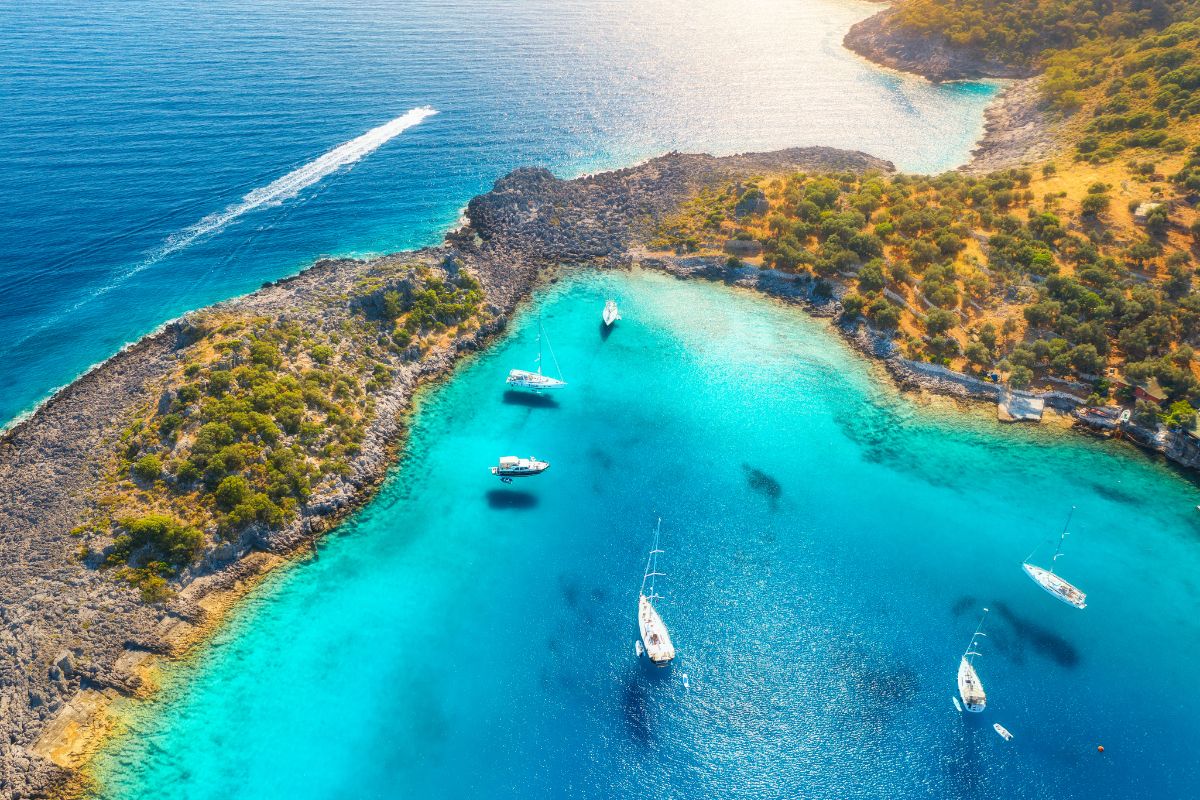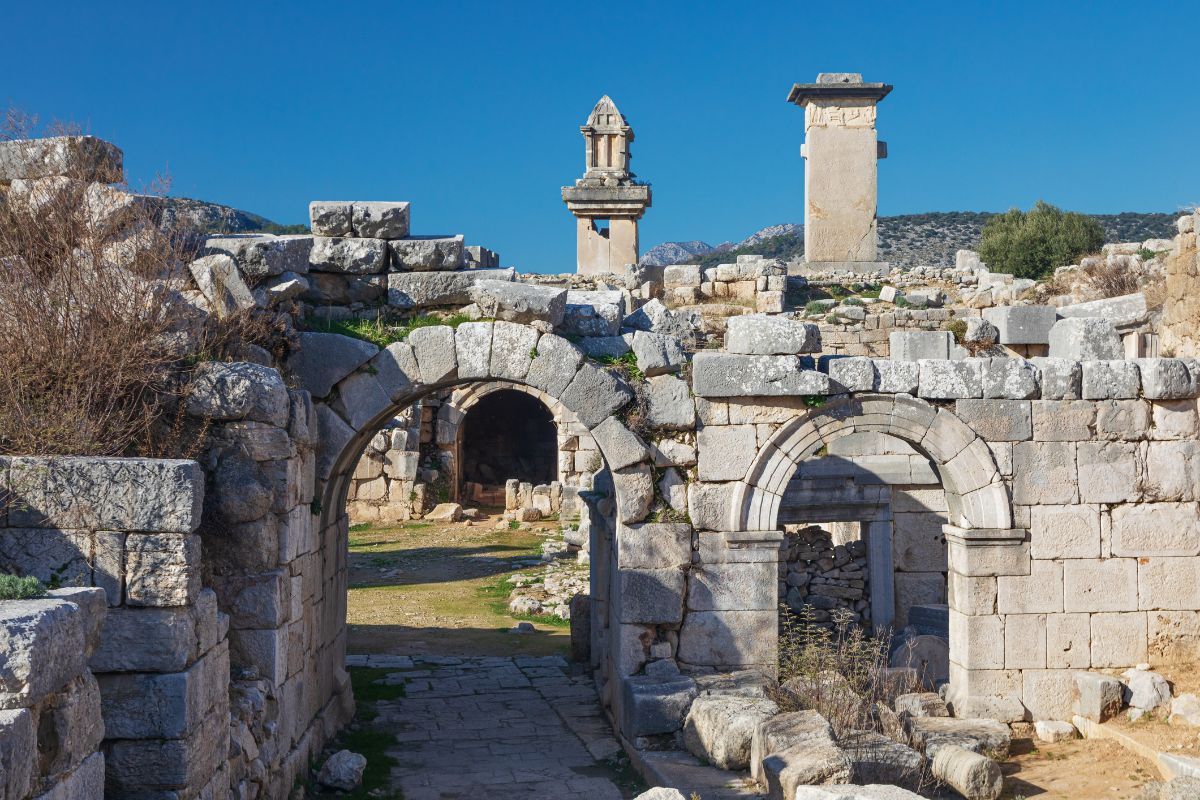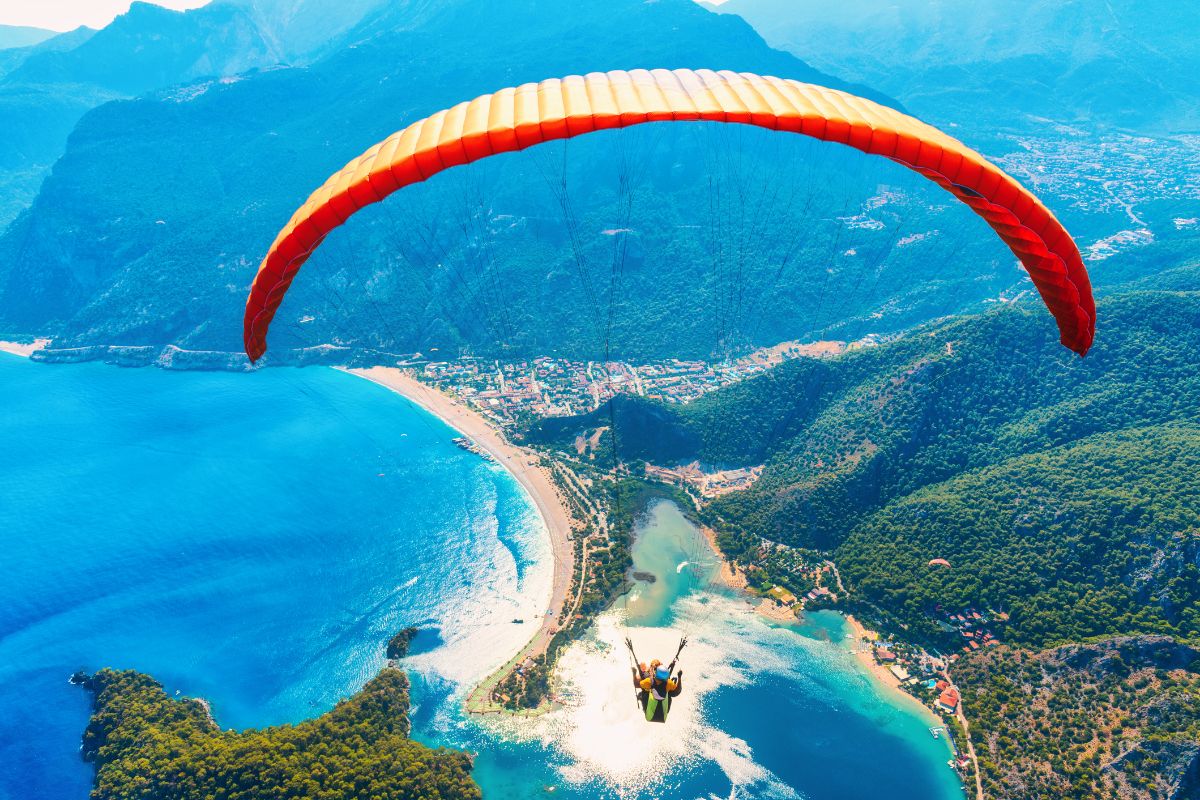Fethiye has made a name for itself in the Turkish and world tourism scene as the starting point of the gulet cruises along the Turquoise Coast..
Pero también hay algunos otros atractivos que podrás descubrir antes y/o después de navegar.
En esta página te contamos los detalles para que disfrutes al máximo de lo que ofrece esta ciudad, renacida una y mil veces para deleite de los turistas.
Fethiye is located in the heart of the Turquoise Coast, that enchanting coastline that extends along the junction of the Aegean Sea and the Mediterranean Sea.
Since ancient times, the region in which it is located was called Lycia, which is actually a large peninsula.
Today, it is part of the province of Mugla and this city has well over 150,000 150,000 inhabitantsto which must be added an important seasonal population of tourists of tourists in the warm season (April to September).
The location of the city itself is also interesting and conducive: at the gates of a narrow bay, the city is narrow bayclosed on its southwestern arm by a gentle wooded hill that gives a green touch to the city’s panorama.
To give you an idea of how close or far they are from other destinations in the country, here is a list of the following list of distances:

The climate of Fethiye is comparable to that of other nearby coastal towns: with a classification Csa classification on the Köppen scale (typical Mediterranean)Fethiye is characterized by a mild winter (minimum temperatures that do not drop below 5ºC) and humid (10-12 days of rainfall per month between November and March), while its summer is hot (maximum temperatures around 35ºC) and dry.
That, together with the fact that the main activity of the city are the sailboat rides (gulet), makes the low season in Fethiye is very quiet and the high season is much busier.
There are several transportation options to reach Fethiye from other parts of Turkey and also from other countries.
These are listed below.
The closest airport to Fethiye is Dalaman (IATA code: DLM)located about 45 km west (about 45 minutes by road) and also serves the city of Marmaris.
This airport receives international flights, mostly from European cities.
This is the list:
Belgrade (Serbia), Berlin, Düsseldorf, Frankfurt, Hamburg, Hannover, Munich, Stuttgart (Germany), Aberdeen, Glasgow, Bristol, Bournemouth, Exeter, Leeds, East Midlands, Doncaster, London, Manchester, Newcastle, Birmingham (United Kingdom), Ercan (Northern Cyprus), Riga (Latvia), Amsterdam, Eindhoven, Groningen, Rotterdam (Netherlands), St. Petersburg (Russia), Billund, Copenhagen (Denmark), Oslo (Norway), Stockholm (Sweden), Kiev (Ukraine).
In addition, Dalaman airport is served by scheduled domestic flights domestic scheduled flightsThe airport also operates regular domestic flights to and from the country’s two main cities, Istanbul and Ankara.
Fethiye is crossed by the D400 highwaywhich is the main road axis of the Turquoise Coast, and connects (although with a different numbering) the cities of Izmir, Aydin and Antalya, parallel to the sea.
If you plan to drive, these are the dur ations of the routes from the country’s main cities:
Fethiye station, about 2 km from the center, is not very big but it hosts a busy flow of buses, especially in the high season, coming from the main coastal towns around from the main coastal towns in the surrounding area and, in some cases, from other major cities.
It stands out, for its variety and frequency, its connection with Antalya and Marmaris, but some major companies such as Kamil Koç offer direct routes. from large cities such as Istanbul such as Istanbul or Ankara.
The port of Fethiye is relatively small and does not does not accommodate large cruise shipsIt does have enough capacity to be the starting point for two main types of cruises.
On the one hand, the gulet cruises (typical Turkish sailboat), which usually last several days.
On the other hand, the regular ferry lines from the Greek island of Rhodes.
Si tu intención es acceder a Fethiye desde este lugar, infórmate de los trámites aduaneros que deberás completar, pues se trata de un viaje internacional entre dos puertos ubicados en países y continentes distintos.
Unfortunately, there is no option to get to Fethiye by trainThis area of the Mugla region is not served by any railway line.

The history of Fethiye dates back to several centuries before the birth of Christ, and its most transformative episodes have been taking place until the end of the 20th century, resulting in the resort town we know today.
Originally, Fethiye was not called Fethiye, but rather Telmesoand existed already in the time of the Hittite empire (which called it Kuwalapašša).
But the name of Telmeso was given by the liciosIt enjoyed a certain prestige in antiquity, especially because some of its inhabitants were considered to have divinatory powers.
It suffered several external conquests and domination, mainly from the Achaemenid of the Achaemenid Persian empire in the 6th century B.C. (who placed it under the rule of the satrap of Caria) and later accepted subordination to Alexander the Great and the later Lagarids and Seleucids.
The Romans exercised their control over it since 188 BC, but it did not experience the development of other surrounding cities.
In fact, it experienced a certain decadence in the period Byzantinenot without sieges and harassment by the Arabs. Arabs in the 7th and 8th centuries.
And it was at this time that the city changed its name twice: first, Anastasioupolis and later, Makriand the latter was maintained until the 20th century.
In the 13th century it came under the control of the Beylicate of Menteşe (‘heirs’ of the Seljuk Sultanate of Rum), later it was the object of desire of the crusader knights in their expansion project from Rhodes and some time later, it was integrated into the Ottoman Empirein the fifteenth century.
And without much relevant news, it arrived until the late nineteenth and early twentieth centuries, when it experienced further growth thanks to the Greek population that settled here.
But this Greek Greek population had to leave as a result of the exchange of populations between Turkey and Greece, in agreement for the end of the Turkish War of Independence, in 1922.
A decade later, the decision was taken to change the name of Makri from Makri to Makri. Fethiye, in honor of the pilot Fethi Beyfamous in the country for being the first to attempt a direct flight between Istanbul and Cairo (although he died when his plane crashed near Damascus).
But the big blow to the city came in 1957: an earthquake devastated the cityThe damage was caused by the flooding, damaging or destroying 90% of the buildings.
This was the final straw for many of Fethiye’s historic buildings, especially those of ancient Telmeso, resulting in fewer monumental spaces than in other destinations in the area.
In any case, Fethiye has managed to reposition itself on the tourist scene and has now positioned itself as a major port of departure for gulet cruises, which, although concentrated in the warm season, are a mainstay of the local economy.

Although many of the historic buildings have disappeared due to the vicissitudes of history and geology (earthquakes), some are preserved and can even be seen around the city.
The most striking are the Lycian sarcophagi that are scattered along some streets in the center, such as Atatürk Caddesi or Kaya Caddesi: they are funerary constructions dating back five centuries before our era.
More monumental, although more distant, is the Tomb of AmintasThe tomb of Amintas, from the 4th century B.C., located on a steep natural wall south of the town, is carved into the rock and decorated with pediments and Ionic columns.
Very old is also the theater of Fethiyelocated in the center and near the port: it was the theater of the Roman Telmeso (second century BC), with capacity for about 6,000 people.
And another place of historical interest is the fortress of the crusaders of the Order of St. John, whose vestiges are on a hillside south of the city: only the ruins of a tower remain, but the views of the city give charm to the battered place.
In addition to these points of interest, it is worth mentioning the Museum of Fethiyewhere you can see pieces rescued in archaeological excavations, mainly from ancient Telmeso, but also from the Byzantine Makri.
Finally, it is also advisable to take a stroll along the promenade (Kordon)(Kordon), dotted with cafes and small moored boats, where visitors can soak up the holiday atmosphere that reigns here, especially in high season.

As we were saying, Fethiye is known worldwide for being the starting point of the point of departure for cruise ships Turkey’s most charming: the gulets (typical sailboats) that travel along the Turquoise Coast.
They usually last several days, stopping in such beautiful places as Oludeniz, Kalkan, Kaz, Uçagiz and Kalekoy. In this page we develop these cruises in more depth.
It is also possible to find other proposals related to the sea, for example diving dives with specialized instructors, for which we depart by boat from Fethiye to reach one of the dive sites adapted to the level of the participants.
There is no shortage of classic Turkish bathsThe Hammam Fethiye Historic Hammam, so called because part of the enclosure dates back to the sixteenth century.
In addition to the usual water baths at different temperatures, there are other services such as massages and aromatherapy.
Finally, as a family proposal, in Fethiye there is a water park: Orka World water park: Orka World Waterparkopen during the warm season (May to October).
For those who wish to move around Fethiye by public transport, they have the option of using city buses (dolmus)The most comfortable and not exactly expensive option, however, is the one that takes you to the main avenues of the city.
However, the most comfortable and not exactly expensive option is that of the cab.
También hay oficinas de alquiler de coches.
En cambio, no encontrarás en Fethiye ni Metro, ni tranvía ni ferrocarril.








